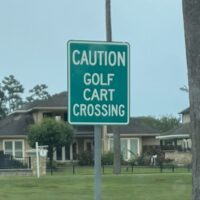Staying On Par

If it seems like you’ve been seeing more and more golf carts cruising around neighborhood streets, city parks, and other unexpected places (i.e., anywhere other than a golf course), no, you’re not going crazy. Golf carts are on the rise in Texas.
In a state that tops lists for home sales in master planned residential areas and boasts the 3rd highest number of golf courses in the country, it is no surprise that golf carts are popping up across Texas communities – and more specifically in the Greater Houston area. With the golf cart trend looking to stick around, Texas cities need to get familiar with the laws governing their use within the municipal bounds.
Under Texas state law a golf cart is defined as “a motor vehicle designed by the manufacturer primarily for use on a golf course” (Trans. Code Sec. 551.401). This distinguishes it from a bicycle, a moped, or other low-powered vehicles – all of which have slightly different rules. The laws of golf cart operation in Texas can be a little complex, but there is one overarching regulation: all drivers must be licensed (Trans. Code Sec. 521.021). In a 2021 opinion, the Attorney General found that this universal requirement for all “motor vehicles” extends to all golf cart operations (Tex. Att’y Gen. Op. No. KP-0364).
Answering the question of who is simple enough. Things get complicated when attempting to determine the question of where. According to the Texas Transportation Code, a golf-cart driver has 3 options of travel:
- in a master planned community
- on a public or private beach open to vehicle traffic
- on a public roadway, during the daytime, where the speed limit is less than or equal to 35 miles per hour AND the golf cart is less than 5 miles from where it is normally parked and being used for transport to or from a golf course
(Trans. Code Sec. 551.403, emphasis added)
From these options more questions arise.
- What even is a master planned community? In relation to golf carts, Texas Trans. Code Sec. 551.403(1) defines it as:
A. a residential subdivision as defined by Sec. 209.002(9) of the Property Code, or has a set of uniform restrictive covenants; AND
B. has one or more approved plats by a county or municipality.
- Under Sec. 551.403(a)(3), I can only drive my golf cart on public roadways on the way to or from a golf course? Yes. As affirmed by an Attorney General opinion in 2012, operation under Texas Trans. Code Sec. 551.403(a)(3) is only for the purpose of transportation to or from a golf course. (Tex. Att’y Gen. Op. No. GA-0966).
- What if I am driving my golf cart on a road that is less than or equal to 35mph and I have to cross a road that has a higher speed limit? Don’t fret! Under Trans. Code Sec. 551.405, crossing an intersection with a posted speed limit higher than 35mph is permitted.
That doesn’t seem too hard. But wait, there’s more!
The Transportation Code allows for municipalities and counties to prohibit golf cart operation in the interest of safety – a power that is also given to the Texas Department of Transportation (Trans. Code Sec. 551.4031).
Conversely, the Code also allows municipalities (and certain coastal counties) the option to authorize golf cart operation on all public roadways with a speed limit less than or equal to 35mph within their boundaries. (Trans. Code Sec. 551.404). In the case that a golf cart is operating under this section, it must also have the following equipment:
- headlamps
- taillamps
- reflectors
- parking brake
- mirrors
(Trans. Code Sec. 551.4041)
Finally, a golf-cart driver must display a license plate on the vehicle before operating a golf cart in Texas, unless you are operating that golf cart in a master planned community where the speed limit is 35mph or less (Trans. Code Sec. 551.402(b), and 551.403(b)).
All in all, before huffing and puffing and brandishing your 7-iron toward the golf-cart zooming quietly past your neighborhood swimming pool, make sure to check local ordinances and understand the scenarios and situations in which these popular vehicles can be operated.
Please do not rely on this article as legal advice. We can tell you what the law is, but until we know the facts of your given situation, we cannot provide legal guidance. This website is for informational purposes and not for the purposes of providing legal advice.
